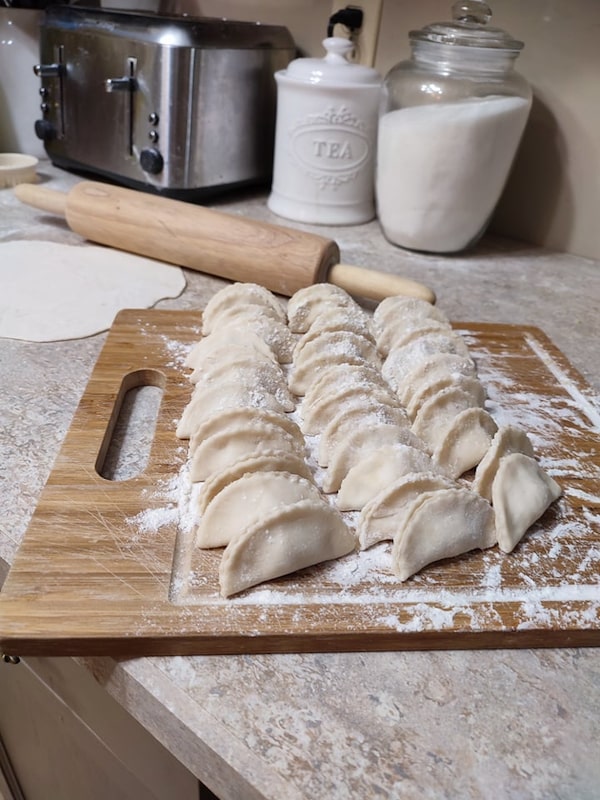
Mandy from the Cozumel Pierogy Factory.Cozumel Pierogy Factory
It was the start of 2021 and Tina Elgee, a Canadian living in Australia, was homesick. Like many expats affected by the pandemic, she hadn’t been home (in her case, to Fredericton) in more than a year.
Craving comfort food, she made perogies and decided to offer them up to members of the “Melbourne Canadians” Facebook group. Within minutes, she had dozens of requests for the potato-stuffed dumplings.
“It blew up,” says Elgee, who received orders for more than 500 perogies. “My phone was vibrating off the hook. I couldn’t keep up.”
For Canadians living abroad, border closings only intensified cravings for Canadian treats. But as Elgee discovered, the most sought-after item isn’t poutine – it’s perogies.

In Melbourne, Tina Elgee launched The Canuckery, a home-based bakery where she makes up to five dozen perogies per week, alongside Nanaimo bars, tortière and donair spice kits.Handout
In online expat communities, news of local perogy makers spreads like hot gossip. The phone number for a maker from Uzbekistan is frequently exchanged in the “Canadians in Dubai” group. In Thailand, recipes are swapped. In Qatar, expats play host to perogy-making parties, where each attendee brings a filling.
Perogies are unique in that unlike Clamato juice, Coffee Crisp or all-dressed chips, they can’t be sent in a care package. And while passable poutine (or in times of desperation, disco fries, which are made with mozza cheese instead of curds) can be found in restaurants across the globe, perogies are typically a homemade commodity. In many countries, they can be difficult or impossible to find outside at grocery stores.
But what’s unique about this Canadian craving is that they’re not Canadian at all.
Perogy, pierogi, pyrogy, perogy, varenyky, pedaheh – no matter what you call them, the dumplings come from Eastern Europe. They arrived in Canada in the 19th century with Polish and Ukrainian immigrants, who settled first in the Prairies and later in Ontario. With one of the largest Ukrainian diaspora communities in the world – second only to Russia – the food was embraced by Canadians. By the early 1970s, it was in the freezer section of major supermarkets.
Today, Edmonton-based Heritage Frozen Foods (the makers of top-selling frozen brand Cheemo Perogies) produces three million dumplings a day – and estimates Canadians eat roughly one billion frozen perogies a year. Perogies are ubiquitous enough that they’re served at chains such as Swiss Chalet and Boston Pizza, and so beloved that the Albertan village of Glendon erected an eight-metre-tall statue in their honour. Even perogy poutine, perogies topped with cheese curds and gravy, has made its way onto restaurant and food-truck menus across the country.
Calling perogies a “Canadian” food would have babas rolling in their graves, but food writer and culinary historian Gabby Peyton says they’re not unlike ginger beef, donairs or Hawaiian pizza. Their origins may be in another country and culture, but what we eat is a distinctly Canadian adaptation, notable for the addition of cheddar cheese.

Perogies from the Cozumel Pierogy Factory.Cozumel Pierogy Factory
She says while “Canadian” food is often defined as having English or French origins, it’s a limited interpretation.
“Perogies have been in Canada almost as long as the butter tart,” says Peyton, whose forthcoming book, Where We Ate: A History of Dining Out in Canada, examines the origin stories of many popular dishes. “So much of Canadian food is immigrant food. It’s a delicious mishmash of global inspiration and familiar comfort.”
Purists may argue perogies belong to Eastern Europe, but historians such as Peyton point out they likely originated in China. From Asia to Eastern Europe, perogies made their way to Canada, where they were reimagined with fillings such as pizza and curry. And now, the recipe is being rewritten yet again by Canadian emigrants around the world.
In Melbourne, Elgee launched the Canuckery, a home-based bakery where she makes up to five dozen perogies a week, alongside Nanaimo bars, tortière and donair spice kits. In Mexico, Albertan Mandy Gardner runs the Cozumel Pierogy Factory, which has been selling vegan perogies since 2012.

In New Zealand, Kate Serkin, originally from Vancouver, has just celebrated the opening of the Pierogi Joint’s permanent location in Christchurch.The Pierogi Joint
And in New Zealand, Kate Serkin, originally from Vancouver, has just celebrated the opening of the Pierogi Joint’s permanent location in Christchurch. For the past seven years, she’s served what she calls “Canadian comfort food” at farmers’ markets. Now, she’s about to start shipping wholesale, with the goal of “getting pierogi to every woman, man and child in New Zealand.”
“Fifty per cent of my job is introducing pierogi to Kiwis; the other half is connecting with expats and hearing what pierogi means to them,” Serkin says. “There’s so much joy and fulfilment in making them because there’s an emotional connection to the people buying them.”
For Serkin, it’s not just a business; the Pierogi Joint is a way of keeping a tradition alive.
“With COVID, we can’t go home. So being able to share something from home with my five-year-old son is super special,” she says. “I don’t think we really appreciate the food in our own country until we leave it.”
Plan your weekend with our Good Taste newsletter, offering wine advice and reviews, recipes, restaurant news and more. Sign up today.